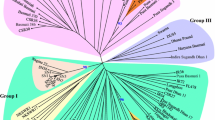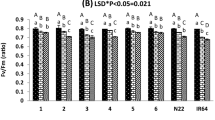Abstract
A total of 300 germplasm accessions collected from submergence-prone areas of Bangladesh were selected from the genebank of the Bangladesh Rice Research Institute (BRRI) for an allelic diversity study on submergence tolerance during the vegetative stage. Through screening under controlled submergence for three consecutive years, eight accessions were selected for having submergence tolerance with survival ranging from 71.2 to 95.4 %. A total of 20 SUB1-region SSR and Indel markers, spanning from 4.5 to 8.6 Mb on chromosome 9, were used to study the allelic diversity of 16 selected rice accessions, including the eight submergence-tolerant accessions and eight sensitive and tolerant checks. A total of 58 alleles were detected at the loci of the 20 markers across the 16 rice accessions. The number of alleles per locus ranged from two to five, with an average of 2.90 alleles across the 20 loci. Genetic similarity analysis using the unweighted pair-group method using arithmetic mean (UPGMA) clustering system generated two major genetic clusters, each of them with three subgroups. DG1-349, Kalojoma, DSL-78-8, Damsi and Putidepa were identified as having higher submergence tolerance but not possessing the same resistance allele as FR13A. Furthermore, RT-PCR analysis of SUB1A, the gene underlying the SUB1 QTL, showed that the transcript abundance in these accessions was significantly less than that of FR13A. Thus, these accessions were selected as potential genetic donors for identifying novel submergence-tolerance QTLs.


Similar content being viewed by others
References
Cavalli-Sfoza LL, Edwards AWF (1967) Phylogenetic analysis: models and estimation procedures. Am J Hum Genet 19:233–257
Chakrabarthi BK, Naravaneni R (2006) SSR marker based DNA fingerprinting and diversity study in rice (Oryza sativa L.). Afr J Biotechnol 5:684–688
Das KK, Panda D, Sarkar RK, Reddy JN, Ismail AM (2009) Submergence tolerance in relation to variable floodwater conditions in rice. Environ Exp Bot 66:425–434
Hossain MZ, Rasul MG, Ali MS, Iftekharuddaula KM, Mian MAK (2007) Molecular characterization and genetic diversity in fine grain and aromatic landraces of rice using microsatellite markers. Bangladesh J Genet Plant Breed 20:1–10
Iftekharuddaula KM, Newaz MA, Salam MA, Ahmed HU, Mahbub MAA, Septiningsih EM, Collard BCY, Sanchez DL, Pamplona AM, Mackill DJ (2011) Rapid and high-precision marker assisted backcrossing to introgress the SUB1 QTL into BR11, the rainfed lowland rice mega variety of Bangladesh. Euphytica 178:83–97
IRRI (2002) Standard evaluation system for rice. Int. Rice Res. Inst, Los Baños
Jackson MB, Ram PC (2003) Physiological and molecular basis of susceptibility and tolerance of rice plants to complete submergence. Ann Bot 91:227–241
Jain S, Mictchell SE, Jain RK, Kresovich S, McCouch SR (2003) DNA fingerprinting and phylogenetic analysis of Indian aromatic high quality rice germplasm using panels of fluorescent-labeled microsatellite markers. In: Kush GS, Brar DS, Hardy B (eds) Advances in rice genetics. IRRI, Philippines, pp 162–166
Lee KW, Chen PW, Lu CA, Chen S, David Ho TH, Yu SM (2009) Coordinated response to oxygen and sugar deficiency allow rice seedlings to tolerate flooding. Sci Signal 2(91):ra61. doi:10.1126/scisignal.2000333
Liu K, Muse SV (2005) PowerMarker: integrated analysis environment for genetic marker data. Bioinformatics 21:2128–2129
Mohanty HK, Mallik S, Grover A (2000) Prospects of improving flooding tolerance in lowland rice varieties by conventional breeding and genetic engineering. Curr Sci 78:132–137
Neeraja C, Maghirang-Rodriguez R, Pamplona A, Heuer S, Collard B, Septiningsih E, Vergara G, Sanchez D, Xu K, Ismail A, Mackill D (2007) A marker-assisted backcross approach for developing submergence-tolerant rice cultivars. Theor Appl Genet 115:767–776
Nei M (1983) Genetic polymorphism and the role of mutation in evolution. In: Koehn PK, Nei M (eds) Evolution of genes and proteins. Sinauer Assoc, Sunderland, pp 165–190
Rohlf F (2002) NTSYS-pc: Numerical taxonomy and multivariate analysis system, 2.1 edn. Department of Ecology and Evolution, State University of New York, Stony Brook
Septiningsih EM, Pamplona AM, Sanchez DL, Neeraja CN, Vergara GV, Heuer S, Ismail AM, Mackill DJ (2009) Development of submergence tolerant rice cultivars: the Sub1 locus and beyond. Ann Bot 103:151–160
Septiningsih EM, Sanchez DL, Singh N, Sendon PMD, Pamplona AM, Heuer S, Mackill DJ (2012) Identifying novel QTLs for submergence tolerance in rice cultivars IR72 and Madabaru. Theor Appl Genet 124:867–874
Septiningsih EM, Collard BCY, Heuer S, Bailey-Serres J, Ismail AM, Mackill DJ (2013) Applying genomics tools for breeding submergence tolerance in rice. In: Varshney RK, Tuberosa R (eds) Translational genomics for crop breeding, vol 2., Improvement for abiotic stress, quality and yield improvement. Wiley-Blackwell, New York, pp 9–30
Septiningsih EM, Hidayatun N, Sanchez DL, Nugraha Y, Carandang J, Pamplona AM, Collard BYC, Ismail AM, Mackill DJ (2015) Accelerating the development of new submergence tolerant rice varieties: the case of Ciherang-Sub1 and PSB Rc18-Sub1. Euphytica 202:259–268
Setter TL, Ellis M, Laureles EV, Ella ES, Senadhira D, Mishra SB, Sarkarung S, Datta S (1997) Physiology and genetics of submergence tolerance in rice. Ann Bot 79:67–77
Siwach P, Jain S, Saini N, Chowdhury VK, Jain RK (2004) Allelic diversity among basmati and non-basmati long grain indica rice varieties using microsatellite markers. J Plant Biochem Biotechnol 13:25–32
Thomson MJ, Septiningsih EM, Suwardjo F, Santoso TJ, Silitonga TS, McCouch SR (2007) Genetic diversity analysis of traditional and improved Indonesian rice (Oryza sativa L.) germplasm using microsatellite markers. Theor Appl Genet 114:559–568
Toojinda T, Siangliw M, Tragoonrung S, Vanavichit A (2003) Molecular genetics of submergence tolerance in rice: QTL analysis of key traits. Ann Bot 91:243–253
Xu K, Mackill DJ (1996) A major locus for submergence tolerance mapped on rice chromosome 9. Mol Breed 2:219–224
Xu K, Xu X, Ronald PC, Mackill DJ (2000) A high-resolution linkage map of the vicinity of the rice submergence tolerance locus Sub1. Mol Gen Genet 263:681–689
Xu K, Xu X, Fukao T, Canlas P, Maghirang-Rodriguez R, Heuer S, Ismail AM, Bailey-Serres J, Ronald PC, Mackill DJ (2006) Sub1A is an ethylene-response-factor-like gene that confers submergence tolerance to rice. Nature 442:705–708
Zheng K, Huang N, Bennett J, Khush GS (1995) PCR-based marker-assisted selection in rice breeding. Int. Rice Res. Inst., Los Baños, pp 1–24
Acknowledgments
This work was financially supported by the BAS Submergence Project (LI 12) under the BAS USDA PALS program and Stress-Tolerant Rice for Africa and South Asia (STRASA) Project funded by the Bill & Melinda Gates Foundation (BMGF), and the Global Rice Science Partnership (GRiSP).
Author information
Authors and Affiliations
Corresponding authors
Ethics declarations
Conflict of interest
The authors declare that they have no conflict of interest.
Human and animal right statement
This research does not involve human participants or animals.
Electronic supplementary material
Below is the link to the electronic supplementary material.
Rights and permissions
About this article
Cite this article
Iftekharuddaula, K.M., Ghosal, S., Gonzaga, Z.J. et al. Allelic diversity of newly characterized submergence-tolerant rice (Oryza sativa L.) germplasm from Bangladesh. Genet Resour Crop Evol 63, 859–867 (2016). https://doi.org/10.1007/s10722-015-0289-4
Received:
Accepted:
Published:
Issue Date:
DOI: https://doi.org/10.1007/s10722-015-0289-4




